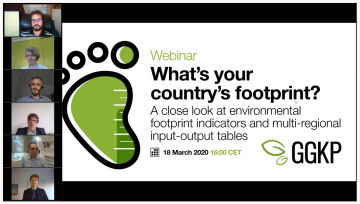 Suppose you were to go to your local café and suppose the coffee you order costs $5. On the surface this seems like a simple transaction, but behind it lies a complex chain of social, economic and environmental relationships and impacts.
Suppose you were to go to your local café and suppose the coffee you order costs $5. On the surface this seems like a simple transaction, but behind it lies a complex chain of social, economic and environmental relationships and impacts.
Let’s break down the price: about $3.50 goes to the café and $1 goes to the barista. The coffee beans have to be transported from where they were grown (usually overseas); the transport costs about $0.50. Coffee bean farmers might receive $0.25, and need to reinvest most of this in seeds, equipment and fertilizers.
These disaggregated costs contribute to the aggregate economic turnover for each relevant sector in a country’s economy, in this case, agriculture, transport and hospitality. When combined with an analysis of the total environmental impacts of these different economic activities, we can start to envision the social and environmental impacts of a $5 coffee across sectors and countries, from export to consumption.
This approach to calculating the total environmental footprint of an economic activity is known as the environmental footprint approach. Each relevant footprint has been assigned an indicator by the Life Cycle Initiative so that they can be measured.
In or out of (planetary) bounds?
 Globalization of trade leads to a global distribution of environmental impacts along supply chains. Those countries that are highly interconnected by trade, such as Switzerland, import many materials and products from other countries to meet their consumption patterns (the coffee hypothetical above, provided by Dr. Arnold Tukker in the GGKP webinar, What’s your country’s footprint?, illustrates this).
Globalization of trade leads to a global distribution of environmental impacts along supply chains. Those countries that are highly interconnected by trade, such as Switzerland, import many materials and products from other countries to meet their consumption patterns (the coffee hypothetical above, provided by Dr. Arnold Tukker in the GGKP webinar, What’s your country’s footprint?, illustrates this).
Thus, measures for sustainable production and consumption (Sustainable Development Goal 12) should not neglect the environmental impacts along global supply chains. However, efforts in achieving such sustainability objectives would be greatly aided by using a framework to monitor progress and by measuring activities against planetary boundaries in order to determine whether they are indeed sustainable, as Switzerland has done.
It is widely recognized that there are planetary boundaries that determine how far we can go because those resources are finite and, unlike coffee, are not easily (or at all) substitutable. So, when we look at the environmental footprints of the consumption of coffee and a country’s overall consumption habits, calculating footprints and comparing them to the environmental boundaries leads to transparency and helps to set appropriate targets for an inclusive green economy or related action plans, thereby assuring that these targets are also sustainable.
There are a number of green economy measurement frameworks available, including those supplied by the Global Green Growth Initiative and the Asian Development Bank. The United Nations Environment Programme (UNEP) also has developed its own framework, the Green Economy Progress Measurement Framework, to assist countries monitor progress in transitioning to an inclusive green economy. This tool is currently on offer to partner countries in the Partnership for Action on Green Economy.
Data and indicators
The Green Economy Progress Measurement Framework (GEPMF) can be applied at the national or regional levels. The underlying concept of the framework is flexible when it comes to selecting indicators on any aspect of an inclusive green economy, providing that appropriate data is available. This customization capability allows the framework to incorporate most indicators related to the Sustainable Development Goals (SDGs).
Using the best available public data to measure progress on selected indicators covering environmental, economic and social dimensions, the coverage provided by the data and indicators influence the overall findings of measurement frameworks like the GEPMF. This is significant when looking at environmental indicators. For example, the United Nations Framework Convention on Climate Change (UNFCCC) uses data and indicators anchored in a territorial, or alternatively called production perspective.
A simple way of looking at this perspective is to revert back to the coffee example and remove the costs and associated environmental impacts of producing the product and services that are incurred overseas (i.e. those linked to the farmer, the fertilizer and overseas transport). The remaining costs and environmental impacts are those incurred within a country’s own borders. Hence, this is considered a territorial perspective.
Just as you can see that this change in perspective provides a different accounting of the costs for that cup of coffee, the change in perspective would also alter the performance of a country on a progress measurement framework, as the external costs related to consuming the coffee are not considered. The Swiss government’s Federal Office for the Environment (FOEN) demonstrated how these two different perspectives provide a different result when monitoring its own progress on a green economy transition.
There are a number of reasons why the UNFCCC and other institutions may opt for a territorial perspective, including uncertainties that arise when obtaining data for the footprint or consumption perspective. It is also important to note though is that the consumption/footprint perspective can complement rather than replace a production/territorial perspective, thereby providing a fuller picture.
Applying three environmental footprint indicators
The Feasibility Study on Strengthening the Environmental Footprints and Planetary Boundaries Concepts within the Green Economy Progress Measurement Framework study was framed around the incorporation of three environmental footprint indicators – greenhouse gasses, biodiversity and water – into the GEPMF. UNEP’s Sustainable Consumption and Production Hotspot and Analysis Tool (SCP-HAT) applies the impact indicators recommended by the Life Cycle Initiative to the UNEP-led International Resource Panel’s data to display the environmental footprints of 170 countries, covering 26 sectors.
As elaborated in the study, the SCP-HAT would provide the source for the three footprints proposed for incorporation into the GEPMF. This approach will also create greater synergies between these two UNEP tools, as well as all products derived from the same database, such as the Global Resources Outlook.
The study concluded that the three footprints can be successfully incorporated into the GEPMF, thereby strengthening the concept of planetary boundaries into this tool.
An upgraded measurement framework
Both the study and the webinar discussions provided recommendations on the way forward regarding the incorporation of the footprints into the GEPMF, and on identifying an official standard multi-regional input-output (MRIO) economic database. The Swiss government has agreed to support UNEP in the incorporation of the three environmental footprint indicators into the GEPMF, and work will commence on this shortly. This incorporation will also be harmonized with upgrades to the SCP-HAT.
With regards to identifying appropriate MRIOs, a positive step has been taken. To upgrade the SCP-HAT, the working group approach UNEP used for lifecycle assessments is being replicated to inform on the appropriate MRIO to be used for this tool. This working group is led by the Vienna University of Economics and Business, and participants include representatives from FOEN, UNEP and ETH Zurich.
These collective efforts will provide comprehensive tools for monitoring and evaluation of the transition to an inclusive green economy. It is up to policymakers, analysts and every one of us to use this information for measures that are compatible with planetary boundaries and take global impacts of consumption and production habits into account. This need not be the death knell for our coffee habits but knowing their footprints would help us to find more sustainable ways to maintain them.
By Adebiyi Odegbile, United Nations Environment Programme (UNEP)

